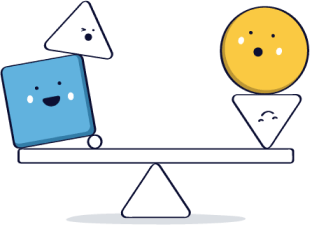Struggling to manage follow-up sales emails while juggling the rest of your sales activities?
Register for our Intro to Nutshell live demo and see why sales teams love us!

Having persistence is critical to establishing success in sales. According to one study of over 11 million sales emails, it takes three emails to make one lead, from the first cold email to getting a positive reply. That’s a lot of work—and time—out of your sales team’s day.
Is following up always worth it, though? Based on our experience and data, 70% of responses are generated by the 2nd to 4th email of the sequence. So without a doubt, yes.
While there’s no “one size fits all” model to writing successful follow-up sales emails, there are a few rules you can rely on to get things moving. Discover some key strategies for writing follow-up sales emails that deliver value, strengthen relationships, and generate leads.
A follow-up sales email is an email sent after a sales representative interacts with a lead, with the purpose of strengthening the relationship and leading to a sale.
What you include in a follow-up email will vary depending on your business goals, industry, the prospective buyer’s interests, and more. However, the goal is always the same: to generate more interest and increase the likelihood of closing a deal.
Follow-up sales emails are an integral part of the sales process and are designed to encourage conversation, spark continued interest, and provide value. Just giving up on the relationship after one interaction is a sure way to lose more sales than you make. Sending a follow-up—and even three, four, or five—gives your prospect the freedom to learn more about your offering and demonstrates that you care about their needs.
A successful follow-up sales email will typically include four parts, including a subject line, opening content, body content, and call to action. Learn more about each of these elements:
Your email’s subject line will either encourage the prospect to open and read your message or move it straight to the trash. Subject lines should be relevant to the relationship and attention-grabbing. For example, a subject line for a follow-up sent after no response will be very different than one for general follow-up, which will be different than one used after a successful conversation.
Captured your recipient’s attention with a great subject line? The first few lines you use in your follow-up email will also have a big impact on whether they keep reading. It’s best to write opening content that continues to hold the reader’s attention while setting the scene for the main content in your email.
The rest of your follow-up email will contain more information related to the goal of the email. Whether you’re trying to set up another sales call, offering free resources, or re-engaging a lead, the body content is where you’ll do most of the work.
Your email’s CTA should be clear and focused, prompting the prospect to take an action that will move them further down your sales funnel. A good CTA will usually promise to provide value even as it encourages the recipient to take a specific action.
While the first follow-up is highly important, experts agree that sending multiple messages in a follow-up email sequence is the best way to ensure a positive outcome. The emails may all have the same goal or have supporting goals with varying CTAs meant to encourage multiple actions.
Every sales email sequence should include at least these three steps:
Without going too deep into details about how to write a cold email, keep it short and include the following elements:
Keep a conversational tone, personalize your content, add value (more on that later), and clearly express what it is you want.
Also, it’s always good to warm up a cold email recipient with a personalized LinkedIn contact request.
Emails tend to be overlooked; your prospect might be busy, not in a good mood to answer, or simply out of office for a few days. You’d be amazed at the power of a simple reminder.
Don’t repeat yourself, though. Follow up in the same thread and simply ask if they saw your previous email, if they got a chance to think about your offer, etc.
I’m about to let you in on a secret.
Seriously, this is the formula for a break-up email that gets a response.
You know how no one wants to miss out, and most people want to help. And also how some people simply need a second reminder?
There’s a single sentence that encapsulates all that. Here it is:
“What could have changed your mind?”
Try to use that as your subject line (or as part of your subject line) and ask in your body text if they can point you to a couple of things that might have swayed their decision.
Why is it so powerful? It makes the reader think about your offer and the reasons they wouldn’t give you an answer. And suddenly, when they type those reasons out, they don’t seem so compelling anymore.

Register for our Intro to Nutshell live demo and see why sales teams love us!

Depending on the importance of the decision, the risk, and the reputation of the company, some follow-up sequences may require more than a few emails and demand more persuasion.
Whereas small transactions may lead to fast decisions, big or complex transactions may require you to establish extra credibility or be more persistent in order for your prospect to wrap their head around the idea of responding to your messages.
This follow-up sales email sequence involves more work but also drives much more value. It helped us recruit our first 175 customers.
Keep in mind that these longer sales email sequences must be integrated into multichannel engagement strategies that will allow you to build a more meaningful relationship.
It runs over a two-week period and looks something like this:
Access email marketing and landing page software connected directly to your Nutshell CRM. Generate leads, organize contacts, segment audiences, track campaigns, and manage communications from a single tool!

There are five main things to include to make your emails incredibly valuable and help your prospect take an action that will move the sales process forward.
Case studies are powerful because they show how one of your customers solved a specific problem successfully and with measurable results. Neil Patel, co-founder of KISSmetrics and Crazy Egg, managed to increase his sales by 70% by including case studies in his emails!
They allow you to grab the attention, demonstrate value, show differentiation, and mitigate the risks.
Success stories are about summarizing the successful experience of a customer with your company, just enough to pique interest. (As opposed to case studies, which focus on the methods implemented to make that experience successful.)
Objections are stories; they’re a projection of what might go wrong or might not work. As Shawn Callahan puts it: “You can’t beat a story with fact, you can only beat it with a better story.”
If you can anticipate the reasons for your prospect’s reluctance, bring them stories that deal with those reasons. Keep in mind that facts alone aren’t generally enough when handling objections.
This time, you’re not the one telling the story—your satisfied customer is. And that can have a tremendous impact.
According to Business Dasher, testimonials placed on a sales landing page can increase conversions by 34%.
They allow you to build trust, sell without selling, and overcome skepticism.
According to Harvard Business Review, referred customers bring in between 30-57% more new customers than other customers. That means more new business with fewer leads.
The best referrals start with an introduction by someone your prospect knows, trusts and respects.
Referrals allow you to bypass the gatekeeper, get you ahead of the competition, earn trust and credibility, and maybe win an introduction from them to another prospect.
If you don’t have any customer data to share—or none that would be relevant to your prospect—you can still offer value by including a piece of valuable content.
It’s easy and it provides you with an opportunity to prove you took the time to understand a prospect’s challenge and find something that could help them solve it without necessarily including your product in the process.
So now you can craft a follow-up sales email and a sales email sequence. How do you boost follow-up email performance? Consider these strategies
The way you implement follow-up sales emails can make or break individual sales as well as your overall sales success rate. Your sales team should spend thoughtful time in the planning stages where you:
From getting leads into your pipeline to managing it effectively, our Sales Pipeline Training Guide can help you transform your sales process to strengthen customer relationships and drive business growth.

Relationships with prospects are all about delivering value—and not just once you close a sale. Showing your leads that you want to make their lives easier by offering value even before you make the sale is a great way to convince them that your product or service will also provide value—and it makes them more likely to listen when it’s time to make your pitch.
Follow-up sales emails that have clearly just been copied and pasted aren’t going to be received well. Prospects want more than a cookie-cutter experience with sales representatives. Take the time to gather data about a lead using prospecting tools and implement personalization in your follow-up emails to provide an experience that’s more personal, from using your contact’s name to referencing a conversation.
The optimal number of follow-up emails in a sequence and the best times to send them depends on many factors, like your industry, sales cycle, prospect’s needs, and more. Experimentation is the best way to find the sweet spot where persistence encourages action without being annoying. Develop a follow-up sales email sequence and use it for a quarter before reevaluating and tweaking the content, cadence, and send time.
Email automation is a sales representative’s secret weapon. With the right email automation tool, you can create personal email sequences that send automatically and are responsive to your recipient’s actions, so you ensure the best possible experience for every lead. Find out as much as possible about your prospect, know what you’re expecting from them, and tailor a follow-up automated email sequence based on that!
Wondering where to find the most qualified prospects? Nutshell has you covered! Nutshell IQ is a complete toolkit for finding more high-quality leads and making more sales by helping you to fill your pipeline with ideal prospects from a database of 200 million contacts, uncovering website visitors who haven’t reached out yet, and finding the decision makers in the companies you’re already corresponding with.
Try Nutshell – and Nutshell IQ – free for 14 days, no credit card required!
Connect with your future buyers and spend less time doing it!
Define your ideal customer and ProspectorIQ does the heavy lifting, so you can add new contacts to your CRM and start making more sales

About Forster Perelsztejn
Forster is currently the marketing manager at Rooftop, a powerful shared inbox and collaboration platform.
Check out his 7 Painful Lessons I Learned From Cold Emailing 943 Companies and connect with him on LinkedIn!


Join 30,000+ other sales and marketing professionals. Subscribe to our Sell to Win newsletter!
 Email & Calendar Sync
Email & Calendar Sync
Use our calculator to add up your total investment of CRM and Add-ons
VIEW ALL PRICING
 Product Info
Product Info Education & Guides
Education & Guides Company
Company